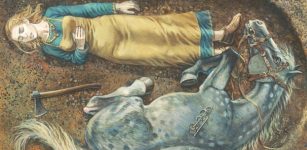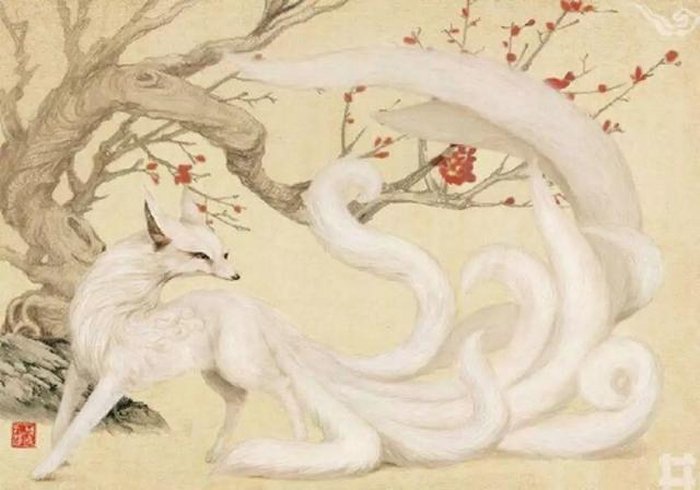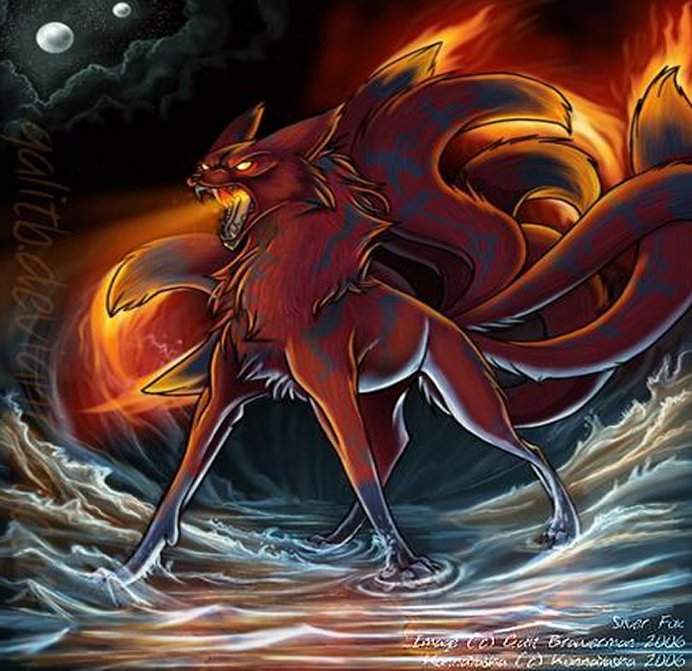Yokai Kitsune: Charming And Cunning Liar With Double Nature In Japanese Folklore
A. Sutherland - AncientPages.com - One of the most important and famous figures in Japanese mythology is Kitsune (‘fox’).
‘Kitsune’ is included in a large group of creatures known as Yokai (yōkai – demons, goblins, spirits, apparitions, leprechauns,) that are feared, admired, and worshiped almost as deities.
These demonic entities are believed to belong to the supernatural world, and they move between their world and the real one. Supernatural forces inhabit virtually every piece of their country, and they have shaped the Japanese culture.
Can We Consider Kitsune As Good Beings?
It seems we can, but we have to be very cautious because kitsune, like many other Yokai, has a dual nature.
Kitsune is a charming and cunning liar that can demonstrate the benevolent nature as a guardian or a devoted companion, and another time tends to misbehave.
But we must not forget that kitsune can easily show the other side of its nature, which is elusive and ruthless. Kitsune likes mischief, pranks and can become a dangerous shapeshifter or soul-possessed enemy demon.
Ancient Japanese literature, historical sources, and local folk tales indicate that this creature exists and represents two opposing aspects of the world, the good and the evil.
You can admire and worship the kitsune, but please remember that the kitsune symbolizes the laws of nature. Therefore, for your own safety, you must also keep a certain distance to it and fear it, too.
Kitsune And The Deity Inari
In the beliefs of the Japanese people, some of the most prominent kami are Amaterasu, Izanagi, Izanami, Susanoo, and Inari, the Shinto deity.
Inari in the Japanese beliefs is the kami (a spirit with holy powers) of the rice fields, and it existed since at least the Nara period (710–784 AD) and had many other responsibilities as a deity of fertility, farming, fishing, cultivation, productivity, prostitution, and the martial art.
A connection between Inari and kitsune has started about the 11th century. This significant cult has about forty thousand shrines scattered across Japan, all decorated with images and statues of these holy foxes guard the entrances to the deity’s temples.
As divine messengers of Inari, they act as a bridge between the human and celestial worlds.
Many early Japanese tales of kitsune can be traced back to China, where the creature was also known for its shape-shifting talents, most notoriously taking on the guise of beautiful, seductive women. Still, they could also suddenly emerge as an older man.
Divinity And Colors of Foxes
In folk beliefs, most kitsune can be red, black, gold, and silver (or white). But not only white (silver) Inari foxes had an aspect of divinity.
Kinko and Ginko (gold and silver kitsune) are two in one as a unity, and incarnation of Yin-Yang dualism. While Kinko is the manifestation of Yin representing the Sun, Ginko, on the other hand, is the manifestation of Yang representing the Moon.
On their backs, they carried the Buddhist goddess Dakini (sacred female spirit in Hinduism and Vajrayana Buddhism).
A white fox – usually understood as a harbinger of death was also Dakini’s private messenger.
Kitsune Likes To Feed On Life Energy Of People
According to mythology, Kitsune (known by different regional names) is a multitalented spirit mentioned in the earliest Japanese texts.
 Statue of kitsune at Inari Temple in Tōdaiji in Nara, Japan. Source
Statue of kitsune at Inari Temple in Tōdaiji in Nara, Japan. Source
Mythological sources confirm two types of kitsune: the ‘zenkos,’ also known as ‘Inari Foxes,’ who are the deity’s messengers; the second group represents ‘yako’ (wild foxes) that can be bad and even evil, and associated with chaos. They are said to feed on the life energy of people or their spirits.
They had transformation ability and most often took the form of a beautiful young woman or monk. However, the length of the transformation was dependent on the age of kitsune. Foxes that were at least five hundred years old could last in any form for a very long time.
Young, inexperienced kitsune could not wholly transform, and their tails were often sticking out from under their clothes.
See also:
Nurikabe: Trickster That Manifests Itself As Invisible, Impassable Wall In Japanese Old Beliefs
Demon Oni: Cruel Harbinger Of Disease And Misfortune In Japanese Folklore
In the ‘Nihonshoki’ - the first official source of history of Japan, and even an essential reference for Japanese myth – the creatures appear as omens, either good or bad.
It sometimes happened that their malice was so painful that as a consequence, the creatures led the unfortunate person to mental illness and even death.
In Japanese mythology, the fox could have another tail every hundred years, and those who have lived for a thousand years had as many as nine tails and possessed the ability to see as far as possible.
The more tails a kitsune has, the older, wiser, and more powerful it is.
Kitsune And Good Harvest
An ancient belief says that farms that always were successful with a good harvest must have any unique association with foxes, which in some way, could contribute to the people’s wealth. These people were believed to be the so-called ‘kitsune-mochi families’ (the owners of kitsune. In consequence, they were protected by yokai spirits, who cared for the family’s good harvest and wealth of the household and warded off evil spirits.
Because of their potential power and influence, some people make sacrifices to kitsune as to a deity by offering fried soybean curd at Inari shrines, a food, which is a favorite of foxes.
Written by – A. Sutherland - AncientPages.com Senior Staff Writer
Copyright © AncientPages.com All rights reserved. This material may not be published, broadcast, rewritten or redistributed in whole or part without the express written permission of AncientPages.com
More From Ancient Pages
-
 Is The Legendary Tsuchinoko Real?
Featured Stories | Aug 21, 2019
Is The Legendary Tsuchinoko Real?
Featured Stories | Aug 21, 2019 -
 New Discovery: Fragments Of Pyramid Dated To 13th Dynasty Discovered In Dahshur Necropolis
Archaeology | Apr 3, 2017
New Discovery: Fragments Of Pyramid Dated To 13th Dynasty Discovered In Dahshur Necropolis
Archaeology | Apr 3, 2017 -
 Galileo Galilei’ Long-Lost Letter Reveals His Attempt To Fool The Inquisition And Make Science Independent From Religion
Archaeology | Sep 22, 2018
Galileo Galilei’ Long-Lost Letter Reveals His Attempt To Fool The Inquisition And Make Science Independent From Religion
Archaeology | Sep 22, 2018 -
 Justinianic Plague Struck England Before It Reached Constantinople And It Did Not Wipe Out The Roman Empire
Archaeology | Nov 19, 2021
Justinianic Plague Struck England Before It Reached Constantinople And It Did Not Wipe Out The Roman Empire
Archaeology | Nov 19, 2021 -
 Ledberg Stone (Ledbergsstenen) With Magic Formula Dated To Viking-Era – One Of Most Beautiful Landmarks
Featured Stories | Jan 5, 2023
Ledberg Stone (Ledbergsstenen) With Magic Formula Dated To Viking-Era – One Of Most Beautiful Landmarks
Featured Stories | Jan 5, 2023 -
 Proof That Neanderthals Ate Crabs 90,000 Years Ago Is Another ‘Nail In The Coffin’ For Primitive Cave Dweller Stereotypes
Archaeology | Feb 7, 2023
Proof That Neanderthals Ate Crabs 90,000 Years Ago Is Another ‘Nail In The Coffin’ For Primitive Cave Dweller Stereotypes
Archaeology | Feb 7, 2023 -
 1,600-Year-Old Estate Of Wealthy Samaritan With A Rare Greek Inscription – Discovered
Archaeology | Mar 6, 2019
1,600-Year-Old Estate Of Wealthy Samaritan With A Rare Greek Inscription – Discovered
Archaeology | Mar 6, 2019 -
 Pharaoh Hatshepsut: Skillful And Efficient Female Ruler Who Brought Prosperity To Ancient Egypt
Featured Stories | Mar 22, 2017
Pharaoh Hatshepsut: Skillful And Efficient Female Ruler Who Brought Prosperity To Ancient Egypt
Featured Stories | Mar 22, 2017 -
 Stonehenge’s Monumental Altar Stone Came From Scotland – Not Wales As Previously Thought
Archaeology | Aug 16, 2024
Stonehenge’s Monumental Altar Stone Came From Scotland – Not Wales As Previously Thought
Archaeology | Aug 16, 2024 -
 Tragic Reign Of Caterina Cornaro – The Last Queen Of Cyprus And Patron Of The Arts
Featured Stories | Jul 4, 2019
Tragic Reign Of Caterina Cornaro – The Last Queen Of Cyprus And Patron Of The Arts
Featured Stories | Jul 4, 2019 -
 Sutton Hoo Burials May Belong To Anglo-Saxons Who Fought For The Byzantine Empire – Professor Suggests
Archaeology | Jan 10, 2025
Sutton Hoo Burials May Belong To Anglo-Saxons Who Fought For The Byzantine Empire – Professor Suggests
Archaeology | Jan 10, 2025 -
 Mystery Of The 290-Million-Year-Old Zapata Footprint In New Mexico
Featured Stories | Sep 23, 2020
Mystery Of The 290-Million-Year-Old Zapata Footprint In New Mexico
Featured Stories | Sep 23, 2020 -
 Why Did People Start Eating Egyptian Mummies? The Weird And Wild Ways Mummy Fever Swept Through Europe
Featured Stories | Jun 7, 2022
Why Did People Start Eating Egyptian Mummies? The Weird And Wild Ways Mummy Fever Swept Through Europe
Featured Stories | Jun 7, 2022 -
 Major Puzzle In Mammal Skull Shape Evolution Solved
Evolution | Dec 20, 2023
Major Puzzle In Mammal Skull Shape Evolution Solved
Evolution | Dec 20, 2023 -
 Pi-Ramesse: Pharaoh Ramesses II’s Great Capital Surprisingly Identified In Two Locations
Featured Stories | Jun 9, 2022
Pi-Ramesse: Pharaoh Ramesses II’s Great Capital Surprisingly Identified In Two Locations
Featured Stories | Jun 9, 2022 -
 Modern Horses Have Lost Their Additional Toes, Scientists Confirm
Evolution | Jun 21, 2023
Modern Horses Have Lost Their Additional Toes, Scientists Confirm
Evolution | Jun 21, 2023 -
 Strange Underwater Mini-Pyramid Older Than Stonehenge With Unknown Purpose – Who Built It?
Ancient Mysteries | Sep 12, 2021
Strange Underwater Mini-Pyramid Older Than Stonehenge With Unknown Purpose – Who Built It?
Ancient Mysteries | Sep 12, 2021 -
 Vikings Cared Deeply For Their Animal Companions – Shared Human And Horse Burials Reveal
Featured Stories | Aug 3, 2023
Vikings Cared Deeply For Their Animal Companions – Shared Human And Horse Burials Reveal
Featured Stories | Aug 3, 2023 -
 Dingoes Given ‘Almost-Human’ Status In Pre-Colonial Australia – Archaeological Study Finds
Archaeology | Oct 21, 2023
Dingoes Given ‘Almost-Human’ Status In Pre-Colonial Australia – Archaeological Study Finds
Archaeology | Oct 21, 2023 -
 The Knap Of Howar: One Of The Oldest And Well-Preserved Neolithic Complexes Orkney, Scotland
Featured Stories | Mar 2, 2017
The Knap Of Howar: One Of The Oldest And Well-Preserved Neolithic Complexes Orkney, Scotland
Featured Stories | Mar 2, 2017


